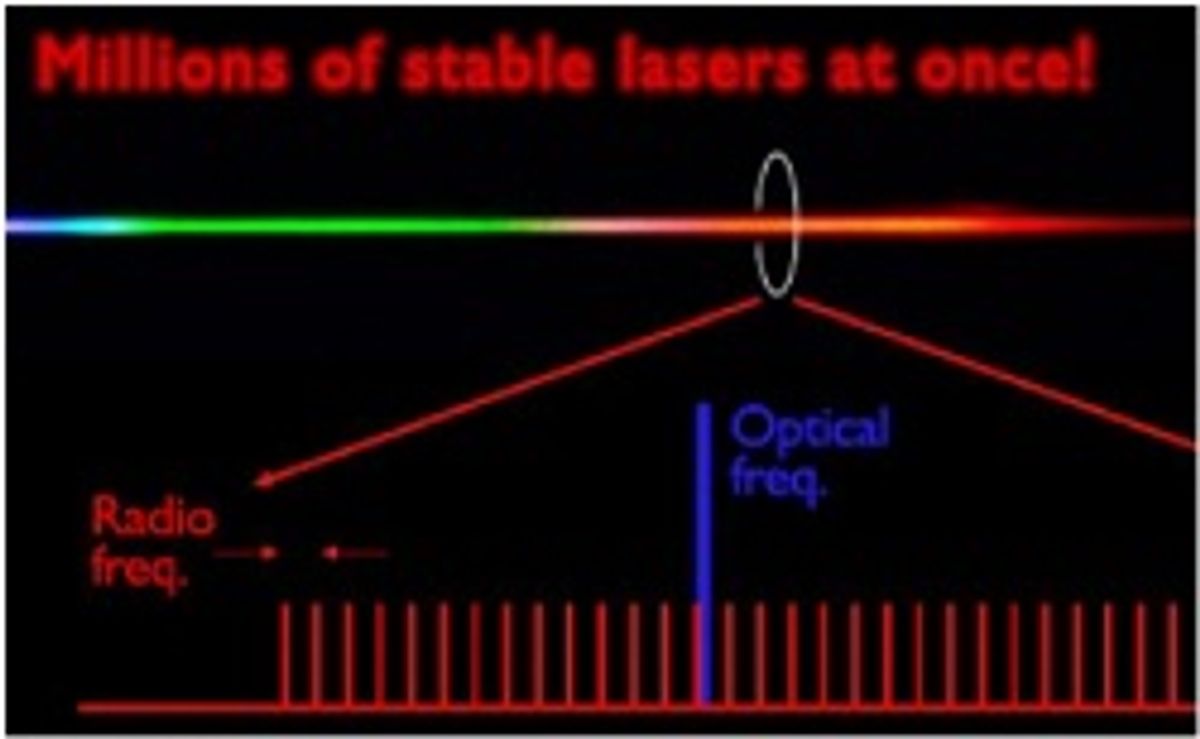“It’s like being able to see the mountain all at once—the whole landscape and the individual trees.” That's how researcher Jun Ye describes direct frequency-comb absorption spectroscopy. Ye and his JILA/National Institute of Standards and Technology colleagues in Boulder, CO, used optical frequency combs to analyze complex gas mixtures for a forthcoming IEEE Transactions on Plasma Science paper on a novel cold-plasma sterilization method.
The system bathes surfaces—agar plates, plastic ID badges (a "major vector for pathogen transmission...currently not subject to any disinfection/sterilization procedures..."), biofilms, and mouse skin (free-radical-rich gases have been shown to disinfect wounds and speed healing)—and mixtures of plasma-derived ozone (O3), hydrogen peroxide (H2O2), nitrous oxide (N2O), and nitrogen dioxide (NO2). It appears to work well, deactivating most surface bacteria in 15 to 60 seconds.
A further object of the study, however, was to discover exactly which gas proportions provided the most effective sterilization. The mix of gases, each with its own pattern of absorption transitions, made monitoring the flow a challenge for conventional Fourier transform infrared (FTIR) absorption spectroscopy.
Enter the optical frequency comb—a more versatile light source for a faster, more accurate update of FTIR to measure the gas mix in real time.
As a spectroscopic light source, the optical frequency comb offers the best of two worlds. White light (now long outmoded) "sees the mountain"; its wide frequency range is ideal for simultaneously detecting multiple energy transitions from many mingled molecular species—but it is an incoherent, ill-defined jumble, so accuracy is poor. It can't see the trees. Continuous wave lasers do see the trees, but they're blind to the mountain; the coherent beams deliver terrific accuracy, but they can usually be tuned only over narrow ranges (and traverse even those slim slices of the spectrum slowly). The optical frequency comb provides both breadth and precision.
The system developed for the forthcoming Transactions in Plasma Science paper uses a mid-infrared optical parametric oscillator (pumped by a high-power femtosecond ytterbium laser) to produce a 150-nm-wide frequency comb straddling a central frequency that can be tuned continuously from 2.8 μm to 4.6 μm. (The optimal central frequency for detecting ozone, hydrogen peroxide, nitrous oxide, and nitrogen dioxide is 3.6 or 3.7 μm.) Since the frequency comb spectrum is discontinuous, it is possible for absorption lines to "fall through the cracks," landing between the teeth of the comb so that they drop out of the data. The optical parametric oscillator can be adjusted, however, to vary both the thickness of the comb's teeth and the spacing between them. With a little thought, researchers can thoroughly cover the necessary frequencies. In return, they can read concentrations of a half-dozen gases in a second or less.
Ye’s lab studies light-matter interactions, and its interests range from frequency combs (they've already built combs that reach into the ultraviolet and are now pushing towards the X-ray regime), laser-cooling of molecules (much more complicated than laser-cooling single atoms), and metrology (including optical clocks and spectroscopy). Medical devices might seem like a stretch, but this isn’t the lab’s first foray into biomedicine. They described a diagnostic breathalyzer in 2008, for example, detecting exhaled trace gases that reflect underlying pathologies. The ubiquity of FTIR in life-science research creates a natural link, though, and the group is talking with instrument-makers about moving optical frequency combs into a lab instrument near you.
Image: Jun Ye Lab/JILA
Douglas McCormick is a freelance science writer and recovering entrepreneur. He has been chief editor of Nature Biotechnology, Pharmaceutical Technology, and Biotechniques.




